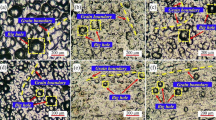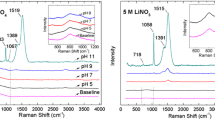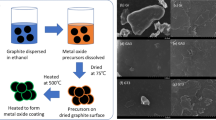Abstract
The effects of current collectors on the battery performance have significant role, especially in aqueous electrolyte Al-ion batteries, as corrosion effects lead to rapid capacity degradation over cycles. To overcome this problem, we present a study investigating the selection of suitable current collectors and their impact on battery performance. Four different current collectors are selected for this. Stainless steel (SS), nickel foil (Ni), titanium foil (Ti) and graphite plate (GP). It has been proven by corrosion tests, cyclic voltammetry and charge-discharge studies that GP is the best current collector by minimizing the corrosion effect and H2 evolution reaction (HER). The anatase phase TiO2 used with GP current collector provides a 249 mAh g−1 initial discharge capacity at a current density of 3 A g−1, while inferior or no electrochemical activity is observed with Ti, SS, Ni current collectors. The observations here provide insights into the selection of corrosion-resistant current collectors to achieve stable battery performance in the field of aqueous electrolyte Al-ion batteries.
Graphical abstract






Similar content being viewed by others
References
Melzack N, Wills RGA, Cruden A (2021) Cleaner Energy Storage: Cradle-To-gate Life Cycle Assessment of Aluminum-Ion batteries with an aqueous electrolyte. Front Energy Res 9:699919
Wu D, Li X, Liu X, Yi J, Acevedo-Peña P, Reguera E et al (2022) Roadmap on aqueous batteries. J Phys Energy. https://doi.org/10.1088/2515-7655/ac774d
Eftekhari A, Corrochano P (2017) Electrochemical energy storage by aluminum as a lightweight and cheap anode/charge carrier. Sustainable Energy & Fuels 1(6):1246–1264
Sun H, Wang W, Yu Z, Yuan Y, Wang S, Jiao S (2015) A new aluminium-ion Battery with high voltage, high safety and low cost. Chem Commun 51(59):11892–11895
Ambroz F, Macdonald TJ, Nann T (2017) Trends in Aluminium-based intercalation batteries. Adv Energy Mater 7(15):1602093
Smith BD, Wills RGA, Cruden AJ (2020) Aqueous Al-ion cells and supercapacitors — a comparison. Energy Rep 6:166–173
Yuan D, Zhao J, Manalastas W, Kumar S, Srinivasan M (2020) Emerging rechargeable aqueous aluminum ion Battery: Status, challenges, and outlooks. Nano Mater Sci 2(3):248–263
Jayaprakash N, Das SK, Archer LA (2011) The rechargeable aluminum-ion Battery. Chem Commun 47(47):12610–12612
Lin M-C, Gong M, Lu B, Wu Y, Wang D-Y, Guan M et al (2015) An ultrafast rechargeable aluminium-ion Battery. Nature 520(7547):324–328
Holland A, McKerracher RD, Cruden A, Wills RGA (2018) An aluminium Battery operating with an aqueous electrolyte. J Appl Electrochem 48(3):243–250
Ru Y, Zheng S, Xue H, Pang H (2019) Different positive electrode materials in organic and aqueous systems for aluminium ion batteries. J Mater Chem A 7(24):14391–14418
Demir-Cakan R, Palacin MR, Croguennec L (2019) Rechargeable aqueous electrolyte batteries: from univalent to multivalent cation chemistry. J Mater Chem A 7(36):20519–20539
Pan W, Wang Y, Zhang Y, Kwok HYH, Wu M, Zhao X et al (2019) A low-cost and dendrite-free rechargeable aluminium-ion Battery with superior performance. J Mater Chem A 7(29):17420–17425
Cheng Y, Liu T, Shao Y, Engelhard MH, Liu J, Li G (2014) Electrochemically stable cathode current collectors for rechargeable magnesium batteries. J Mater Chem A 2(8):2473–2477
Verma V, Kumar S, Manalastas W, Satish R, Srinivasan M (2019) Progress in rechargeable aqueous zinc- and aluminum-Ion Battery electrodes: challenges and Outlook. Adv Sustainable Syst 3(1):1800111
Liu Y, Sang S, Wu Q, Lu Z, Liu K, Liu H (2014) The electrochemical behavior of Cl– assisted Al3+ insertion into titanium dioxide nanotube arrays in aqueous solution for aluminum ion batteries. Electrochim Acta 143:340–346
Kumar S, Rama P, Yang G, Lieu WY, Chinnadurai D, Seh ZW (2022) Additive-Driven Interfacial Engineering of Aluminum Metal Anode for Ultralong Cycling Life. Nano-Micro Lett 15(1):21
Wang H, Bai Y, Chen S, Luo X, Wu C, Wu F et al (2015) Binder-free V2O5 cathode for greener rechargeable aluminum Battery. ACS Appl Mater Interfaces 7(1):80–84
Liu S, Hu JJ, Yan NF, Pan GL, Li GR, Gao XP (2012) Aluminum storage behavior of anatase TiO2 nanotube arrays in aqueous solution for aluminum ion batteries. Energy Environ Sci 5(12):9743
Kazazi M, Abdollahi P, Mirzaei-Moghadam M (2017) High surface area TiO2 nanospheres as a high-rate anode material for aqueous aluminium-ion batteries. Solid State Ionics 300:32–37
Holland A, McKerracher R, Cruden A, Wills R (2018) Electrochemically treated TiO2 for enhanced performance in Aqueous Al-Ion batteries. Mater (Basel) 11(11):2–12
Nandi S, Das SK (2019) Realizing a low-cost and sustainable rechargeable aqueous aluminum-metal Battery with exfoliated Graphite Cathode. ACS Sustain Chem Eng 7(24):19839–19847
Rani JV, Kanakaiah V, Dadmal T, Rao MS, Bhavanarushi S (2013) Fluorinated Natural Graphite Cathode for Rechargeable Ionic Liquid based aluminum–ion Battery. J Electrochem Soc 160(10):A1781
Liu S, Pan GL, Li GR, Gao XP (2015) Copper hexacyanoferrate nanoparticles as cathode material for aqueous Al-ion batteries. J Mater Chem A 3(3):959–962
Vujković MJ, Etinski M, Vasić B, Kuzmanović B, Bajuk-Bogdanović D, Dominko R et al (2021) Polyaniline as a charge storage material in an aqueous aluminum-based electrolyte: can aluminum ions play the role of protons? J Power Sources 482:228937
Sariyer S, Ghosh A, Dambasan SN, Halim EM, El Rhazi M, Perrot H et al (2022) Aqueous multivalent charge storage mechanism in aromatic diamine-based Organic electrodes. ACS Appl Mater Interfaces 14(6):8508–8520
Yan L, Zeng X, Zhao S, Jiang W, Li Z, Gao X et al (2021) 9,10-Anthraquinone/K(2)CuFe(CN)(6): a highly compatible aqueous aluminum-ion full-battery configuration. ACS Appl Mater Interfaces 13(7):8353–8360
Reed LD, Menke E (2013) The roles of V2O5 and Stainless Steel in Rechargeable Al–Ion batteries. J Electrochem Soc 160(6):A915
Oh Y, Lee G, Tak Y (2018) Stability of Metallic current collectors in Acidic Ionic Liquid for rechargeable aluminum-ion batteries. ChemElectroChem 5(22):3348–3352
Lahan H, Das SK (2018) Active role of inactive current collector in aqueous aluminum-ion Battery. Ionics 24(7):2175–2180
Lahan H, Das SK (2019) Al3+ ion intercalation in MoO3 for aqueous aluminum-ion Battery. J Power Sources 413:134–138
Sang S, Liu Y, Zhong W, Liu K, Liu H, Wu Q (2016) The electrochemical behavior of TiO2-NTAs electrode in H+ and Al3+ coexistent aqueous solution. Electrochim Acta 187:92–97
Kim YS, Kriegel S, Harris KD, Costentin C, Limoges B, Balland V (2017) Evidencing fast, massive, and reversible H+ insertion in Nanostructured TiO2 electrodes at Neutral pH. Where Do Protons Come from? The Journal of Physical Chemistry C 121(19):10325–10335
Revie R, Wau HH (2008) Corrosion and Corrosion Control. An introduction to Corrosion Science and Engineering, 4 edn. John Wiley & Sons, New Jersey
Li W, Cochell T, Manthiram A (2013) Activation of aluminum as an effective reducing Agent by Pitting Corrosion for Wet-chemical synthesis. Sci Rep 3(1):1229
Akpanyung KV, Loto RT (2019) Pitting corrosion evaluation: a review. Journal of Physics: Conference Series. 1378(2):022088
Raza MA, Ali A, Ghauri FA, Aslam A, Yaqoob K, Wasay A et al (2017) Electrochemical behavior of graphene coatings deposited on copper metal by electrophoretic deposition and chemical vapor deposition. Surf Coat Technol 332:112–119
McCafferty E (2009) Introduction to Corrosion Science. Springer Science, USA
ASTM (Reapproved 1999) Standard Practice for Calculation of Corrosion Rates and Related Information from Electrochemical Measurements. ASTM standards G102-89. Annual Book of International ASTM Standards
Das SK, Palaniselvam T, Adelhelm P (2019) Electrochemical study on the rechargeability of TiO2 as electrode material for Al-ion batteries with chloroaluminate ionic liquid electrolyte. Solid State Ionics 340:115017
Auer A, Kunze-Liebhäuser J (2019) Recent Progress in Understanding Ion Storage in Self‐Organized Anodic TiO2 Nanotubes. Small Methods 3(8):1800385
Kim YS, Balland V, Limoges B, Costentin C (2017) Cyclic voltammetry modeling of proton transport effects on redox charge storage in conductive materials: application to a TiO2 mesoporous film. Phys Chem Chem Phys 19(27):17944–17951
Makivić N, Cho JY, Harris KD, Tarascon JM, Limoges B, Balland V (2021) Evidence of Bulk Proton insertion in Nanostructured Anatase and Amorphous TiO2 Electrodes. Chem Mater 33(9):3436–3448
Lahan H, Das SK (2018) An approach to improve the Al3+ ion intercalation in anatase TiO2 nanoparticle for aqueous aluminum-ion Battery. Ionics 24(6):1855–1860
Wu X, Qin N, Wang F, Li Z, Qin J, Huang G et al (2021) Reversible aluminum ion storage mechanism in Ti-deficient rutile titanium dioxide anode for aqueous aluminum-ion batteries. Energy Storage Materials 37:619–627
Acknowledgements
Burcu Unal acknowledges the 100/2000 Doctoral Fellowship Program of the Turkish Higher Education Council (YÖK) and the 2211/C National Doctoral Fellowship Program for Priority Areas in Science of the Scientific and Technological Research Council of Turkey (TÜBİTAK). This work is part of Burcu Unal’s PhD thesis.
Author information
Authors and Affiliations
Contributions
B.U. and R.D.C. designed the experiments. B.U. fabricated the cells and performed the electrochemical measurements. O.S. helped interpret the data. All authors wrote the manuscript and approved the submitted version.
Corresponding author
Ethics declarations
Competing interests
The authors declare no competing interests.
Additional information
Publisher’s note
Springer Nature remains neutral with regard to jurisdictional claims in published maps and institutional affiliations.
Supplementary information
Below is the link to the electronic supplementary material.
Rights and permissions
Springer Nature or its licensor (e.g. a society or other partner) holds exclusive rights to this article under a publishing agreement with the author(s) or other rightsholder(s); author self-archiving of the accepted manuscript version of this article is solely governed by the terms of such publishing agreement and applicable law.
About this article
Cite this article
Unal, B., Sel, O. & Demir-Cakan, R. Current collectors corrosion behaviours and rechargeability of TiO2 in Aqueous Electrolyte Aluminium-ion batteries. J Appl Electrochem 54, 1425–1434 (2024). https://doi.org/10.1007/s10800-023-02029-0
Received:
Accepted:
Published:
Issue Date:
DOI: https://doi.org/10.1007/s10800-023-02029-0




